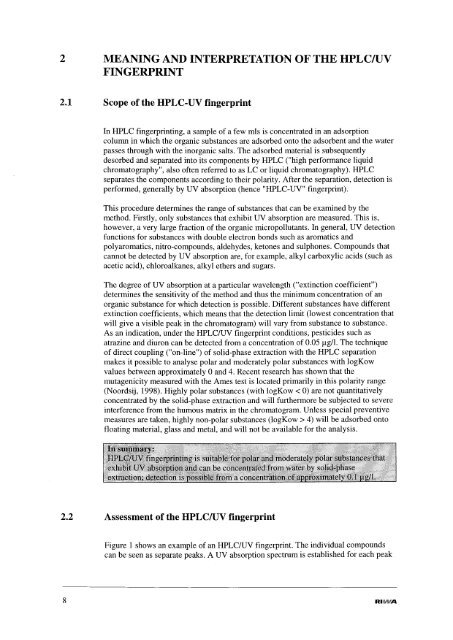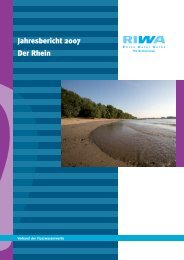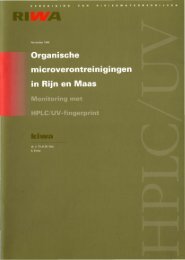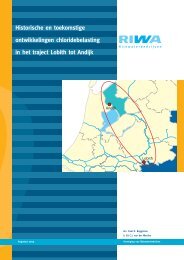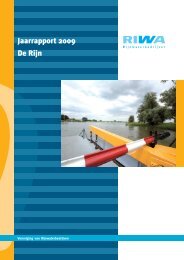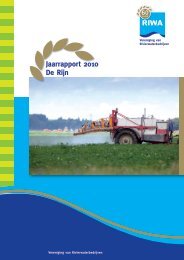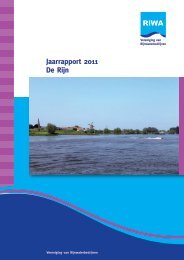Organic micropollutants in Rhine and Meuse a - Riwa
Organic micropollutants in Rhine and Meuse a - Riwa
Organic micropollutants in Rhine and Meuse a - Riwa
Create successful ePaper yourself
Turn your PDF publications into a flip-book with our unique Google optimized e-Paper software.
2 MEANING AND INTERPRETATION OF THE HPLCIUV<br />
FINGERPRINT<br />
2.1 Scope of the HPLC-UV f<strong>in</strong>gerpr<strong>in</strong>t<br />
In HPLC f<strong>in</strong>gerpr<strong>in</strong>t<strong>in</strong>g, a sample of a few rnIs is concentrated <strong>in</strong> an adsorption<br />
column <strong>in</strong> which the organic substances are adsorbed onto the adsorbent <strong>and</strong> the water<br />
passes through with the <strong>in</strong>organic salts. The adsorbed material is subsequently<br />
desorbed <strong>and</strong> separated <strong>in</strong>to its components by HPLC ("high performance liquid<br />
chromatography", also often referred to as LC or liquid chromatography). HPLC<br />
separates the components accord<strong>in</strong>g to their polarity. After the separation, detection is<br />
performed, generally by UV absorption (hence "HPLC-UV" f<strong>in</strong>gerpr<strong>in</strong>t).<br />
This procedure determ<strong>in</strong>es the range of substances that can be exam<strong>in</strong>ed by the<br />
method. Firstly, only substances that exhibit UV absorption are measured. This is,<br />
however, a very large fraction of the organic <strong>micropollutants</strong>. In general, UV detection<br />
functions for substances with double electron bonds such as aromatics <strong>and</strong><br />
polyaromatics, nitro-compounds, aldehydes, ketones <strong>and</strong> sulphones. Compounds that<br />
cannot be detected by UV absorption are, for example, alkyl carboxylic acids (such as<br />
acetic acid), chloroalkanes, alkyl ethers <strong>and</strong> sugars.<br />
The degree of UV absorption at a particular wavelength ("ext<strong>in</strong>ction coefficient")<br />
determ<strong>in</strong>es the sensitivity of the method <strong>and</strong> thus the m<strong>in</strong>imum concentration of an<br />
organic substance for which detection is possible. Different substances have different<br />
ext<strong>in</strong>ction coefficients, which means that the detection limit (lowest concentration that<br />
will give a visible peak <strong>in</strong> the chromatogram) will vary from substance to substance.<br />
As an <strong>in</strong>dication, under the HPLC/UV f<strong>in</strong>gerpr<strong>in</strong>t conditions, pesticides such as<br />
atraz<strong>in</strong>e <strong>and</strong> diuron can be detected from a concentration of 0.05 flg/l. The technique<br />
of direct coupl<strong>in</strong>g ("on-l<strong>in</strong>e") of solid-phase extraction with the HPLC separation<br />
makes it possible to analyse polar <strong>and</strong> moderately polar substances with logKow<br />
values between approximately 0 <strong>and</strong> 4. Recent research has shown that the<br />
mutagenicity measured with the Ames test is located primarily <strong>in</strong> this polarity range<br />
(Noordsij, 1998). Highly polar substances (with logKow < 0) are not quantitatively<br />
concentrated by the solid-phase extraction <strong>and</strong> will furthermore be subjected to severe<br />
<strong>in</strong>terference from the humous matrix <strong>in</strong> the chromatogram. Unless special preventive<br />
measures are taken, highly non-polar substances (logKow > 4) will be adsorbed onto<br />
float<strong>in</strong>g material, glass <strong>and</strong> metal, <strong>and</strong> will not be available for the analysis.<br />
2.2 Assessment of the HPLCIUV f<strong>in</strong>gerpr<strong>in</strong>t<br />
Figure 1 shows an example of an HPLC/UV f<strong>in</strong>gerpr<strong>in</strong>t. The <strong>in</strong>dividual compounds<br />
can be seen as separate peaks. A UV absorption spectrum is established for each peak<br />
8 RIIlN'A


